Years ago, Nick bought me a 10″ x 10″ steel target as a thank-you for introducing him to Texas. It was a big moment in my shooting life as I’d never actually shot at steel targets before. I was floored. Before I found out about the joys of steel, I’d bore holes in paper targets for hours with little or no feedback. In a post steel world, I got an immediate report on whether and where I’d hit or missed. After a dozen or so rounds, though, my feedback was reduced to binary hit or miss due to paint flecking off the steel. AMSEC’s Gravity Spinning Bullseye target changed my usage of steel in a major and very positive way . . .
Two things to get out of the way first. How do you get one? AMSEC doesn’t sell to consumers. And really, steel targets aren’t their main line of business. They build safes like the under-bed one that I’m testing at the moment. But when you build sturdy things out of steel all day, making cool stuff that goes “ping” is a natural outcome.
Since they don’t sell directly to consumers, you can buy through Amazon ($399 + Shipping) or you can use their handy dealer locator to find somebody a bit more local. At the time of this writing, Dean Safe lists this model for $100 less than Amazon. Shipping to my house runs ~$50.
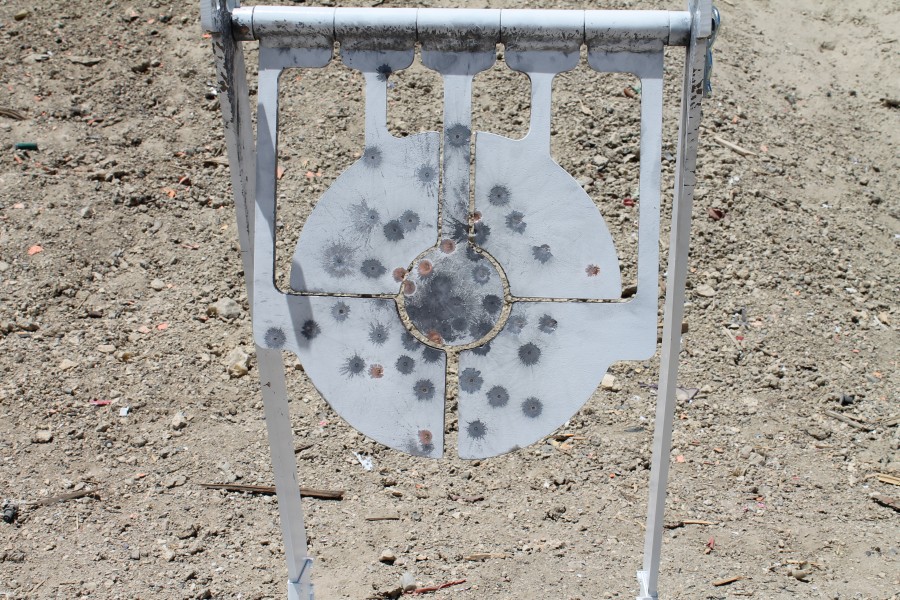
The second thing I want to cover is a bit more intriguing. As you might expect, TTAG makes it a policy to give at least a cursory glance in the direction of the instructions that come with products. I noticed when I read over them that AMSEC designed their targets as pistol targets, and recommends that rifle users start at distances past 150 yards and work their way in.
I flat out didn’t do that. I shot this target with PMC Bronze .223 REM 55 gr and Hornady .243 WIN 80 gr. GMX at distances ranging from 80-100 yards.
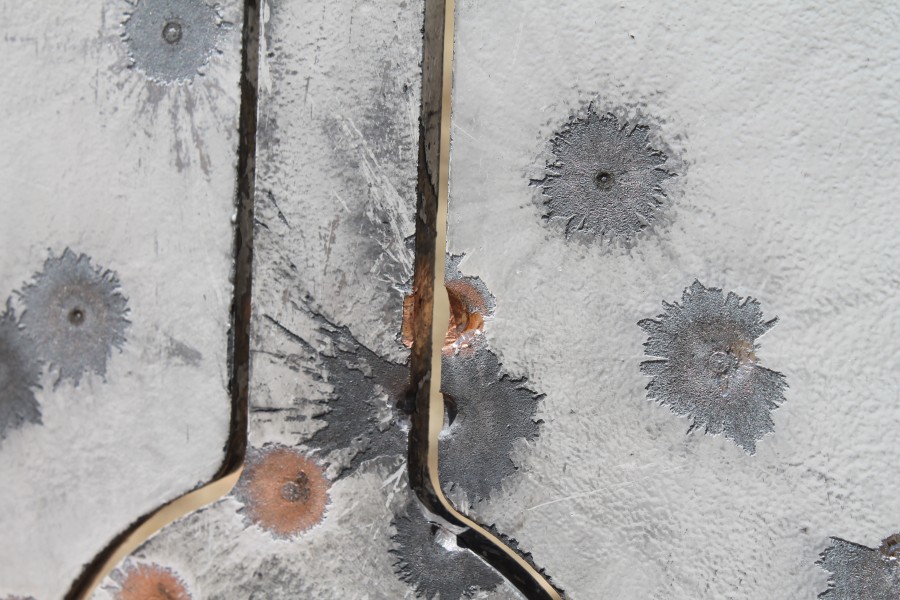
This is directly contradictory to AMSEC’s instructions, but we like to do a bit more “real world” testing on steel targets. Very likely, their customers will shoot these targets at close range with rifles. We’d much rather be the guinea pig for that sort of thing. It turns out there’s a reason for AMSEC’s recommendation – the targets didn’t fare well from that close.
The .223 REM rounds seemed to leave faint impressions in the steel, no different than what I normally see with AR 500 steel of this thickness. You’d have to run a bare hand across the surface to feel them, and in this regard, the AMSEC target stood up nicely.
Given that this target encourages users to shoot at a center swinger surrounded by cut edges, though, hits to the edge of the target are all but inevitable. These hits created a great deal of deformation with .223 REM. This damage was magnified by the GMX rounds.
Speaking of the GMX, know that it is essentially a solid copper projectile. They’re really hard on steel, and the AMSEC target certainly ended up worse for the wear after nine rounds of it. I consider this to be top tier abuse that falls a bit short of firing something like a solid brass .416 Barrett at it. It doesn’t get much worse than an 80 gr. solid copper piece hitting steel at something like 2800 fps.
With all that in mind, if you elect to buy this target, AMSEC doesn’t advocate shooting at it from close in with rifle rounds. That said, its a total gas to shoot this target.
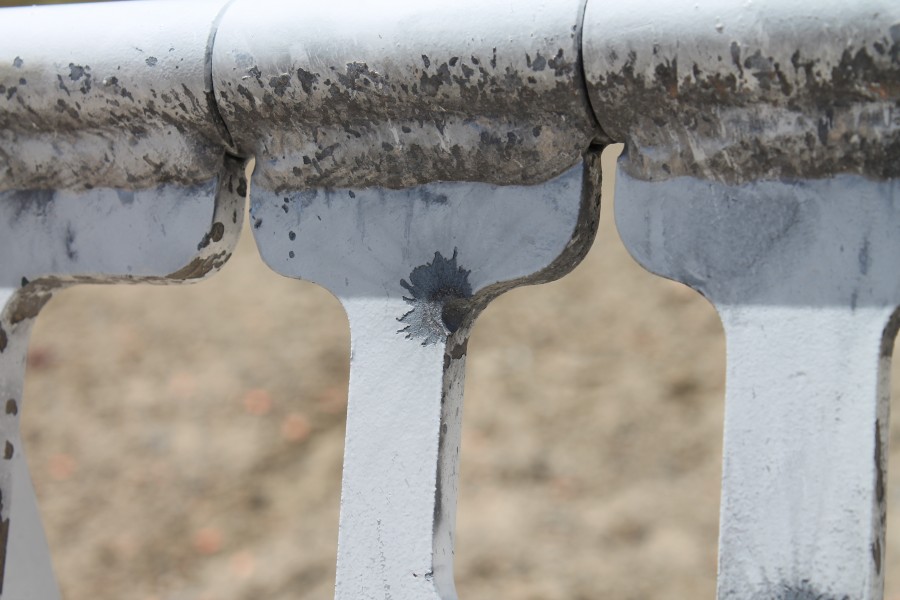
The problem I’ve found with shooting steel is that unless you repaint your targets regularly, shot calling can be a bit difficult. Take a piece of AR 500 with the paint knocked off of it and you’ll be reduced to calling hit or miss only. That’s helpful to a point, but knowing if you were low and left or high and right is much better. This is where the AMSEC target really shines.
The inside circle of the target is 3.75 inches in diameter while the entire shooting surface is a hair over twelve inches. Each of the four quadrants and the inner circle are free to swing on their own. When you hit on of the sections, you’ll get that “ping” that you love, but you can also see the quadrant swinging.
This feature is excellent on the pistol range for diagnosing and giving instant feedback on trigger push and pull, recoil anticipation, and myriad other nasty habits that pop up. It doesn’t take a smart guy with a doctorate in human psychology to figure out that you and your shooting buddies will be competing to see who can ring the center circle the most times in a row.
Did I mention that the center circle spins when you hit it? The first time I made it clang, I actually giggled at the center ring making a complete revolution. If you time your shots correctly, you can get the quadrant targets swinging pretty hard as well. I wasn’t able to get them to make the full revolution, but given sufficient ammo, I think I could make it happen.
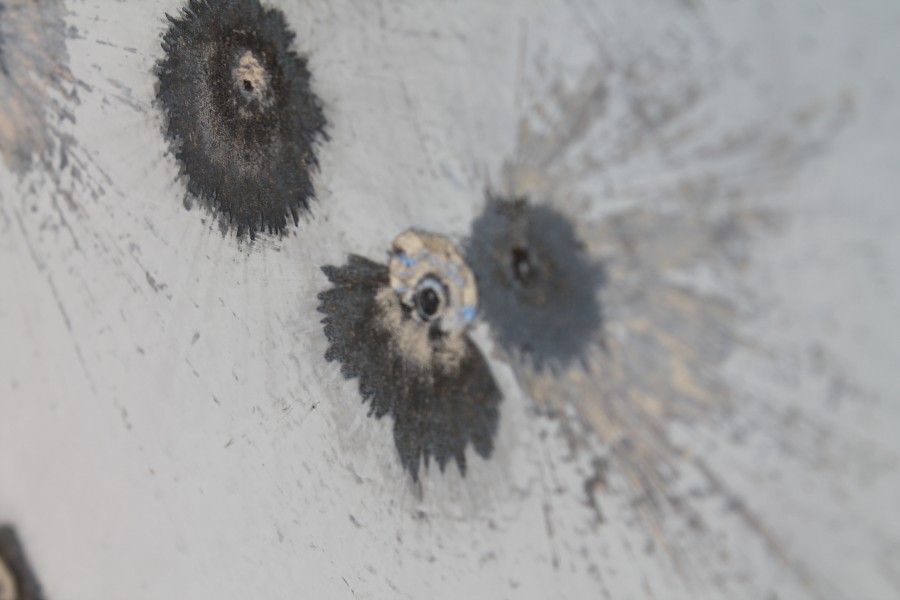
On the rifle range, the AMSEC target is really handy. Remember that the center circle is 3.75 inches and the quadrants on either side are about 4.25 inches. If you and your shooting partner line up on the quarter mile line (440 yards) and start slinging lead, you can pretty easily tell if your buddy’s gun is sub MOA at those distances. The center spinner doesn’t lie.
Furthermore, say the wind is gusting pretty hard that day and the two of you are practicing your wind calls. That 4.25 inch quadrant at 440 yards equates to ~.27 mils. Knowing that, if he’s holding dead on the center target, and you see the left quadrant swinging after the shot breaks, you’ll know that he was anywhere from 0 to .3 mils off. Using that 6.5 Creedmoor chambered Ruger American Predator I just tested as an example, .3 mils at 440 yards is the difference between a 15 mph (1.2 mil), and 19 mph (1.5 mil) wind hold.
I had the opportunity to take this target out to the family land while I was testing the Ruger Precision Rifles back to back. I was lucky enough to get one in .308 and one in 6.5 Creedmoor. Once I’d established the 100 yard zeroes for those guns and punched all the relevant data into my ballistic calculator, I backed up to my favorite shaded spot to start cracking shots at the 465 yard line.
I had my choice of IPSC torso sized steel targets, little squares, and various other pieces of steel to shoot at, but time and time again, I came back to the AMSEC swinger. Over the course of two days, I beat that target up with heavy hitting 6.5 and .308 rounds, and the only damage evident was the stuff I’d already done with the aforementioned GMX rounds.
Thanks to the swinging action, I was able to verify my wind holds and elevation dope against my ballistic calculator within about .25 mils (.253 to be exact). So when I made the low left swinger go nuts five times in a row, I knew that I was holding a bit too much for wind and that I was at least .1 to .3 mils low on my elevation dope without having to get in the truck and drive a half mile round trip to go measure and repaint.
Similarly, I knew that when I was making all four quadrants move with the .308, I was dealing with a gun that was dead on, but slightly less accurate than the 6.5. Putting this all together allowed me to check my dope before moving to a larger piece of painted steel to shoot five shot groups at long range for my reviews of those rifles. .
Specifications: AMSEC Gravity Spinning Bullseye
- 3/8″ AR500 solid steel plate
- Gravity spinning bullseye with heavy duty steel base.
- Reversible plates.
- Size: 15.5″ H x 14.75″ W x 3/8″ D
- Base Size: 33.5″ H x 18″ W x 21″ D
- Weight: 56 Lbs.
- Price: $299 + shipping
Ratings (out of five stars):
Durability * * * *
I can’t fault AMSEC for sending me a target knowing full well that I wouldn’t pay attention to the directions in the interest of destruction. That said, I am knocking a star off for the edge deformation I saw with the .223 rounds. I confirmed with my guy at AMSEC that they cut the target faces with a laser. My understanding of metallurgy (subject to change) is that the heat from laser cutting messes with the temper of the steel creating soft spots subject to the sort of damage I saw. Ultimately, I put the AMSEC target through the worst treatment, and it held up pretty well. Better care and feeding would make for a much longer lasting target.
Utility * * * * *
I cannot say enough good things about how much fun this target is to shoot. Getting the feedback from the individual quadrants moving is a game changer. I didn’t fully realize the utility of that system until I stepped my rifle shooting out past a quarter mile. At those distances, I was able to get immediate feedback beyond hit or miss for hours without having to repaint. And let me tell you, when you hit that center spinner at those distances, you can’t help but smile.
Overall Rating * * * * *
$300 plus shipping is a lot of money for a steel target, but given that IPSC torso targets with stands are usually more expensive than that, this is right in the money for steel targets of that general size and feature set. Out on the range, it has become an indispensable training tool for both pistol and rifle shooting.

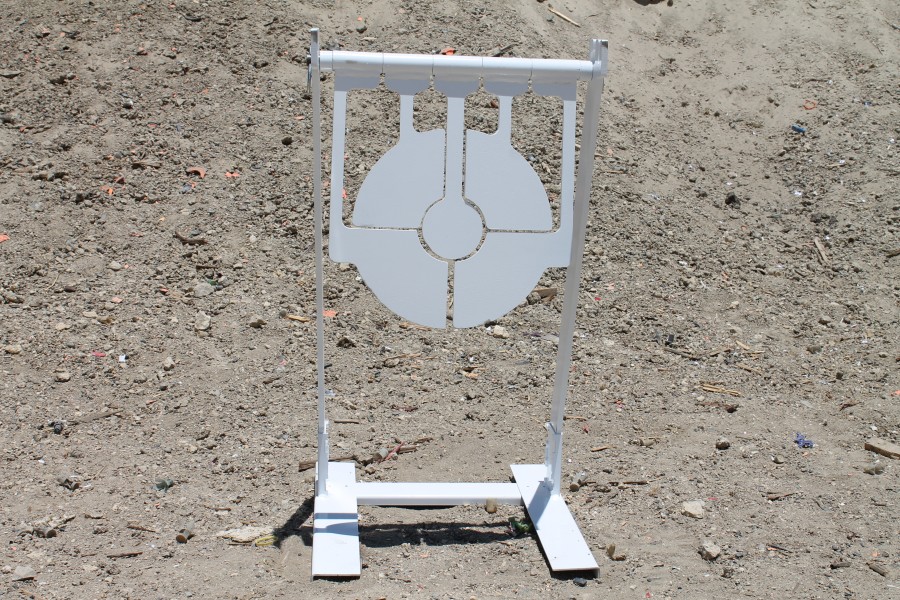
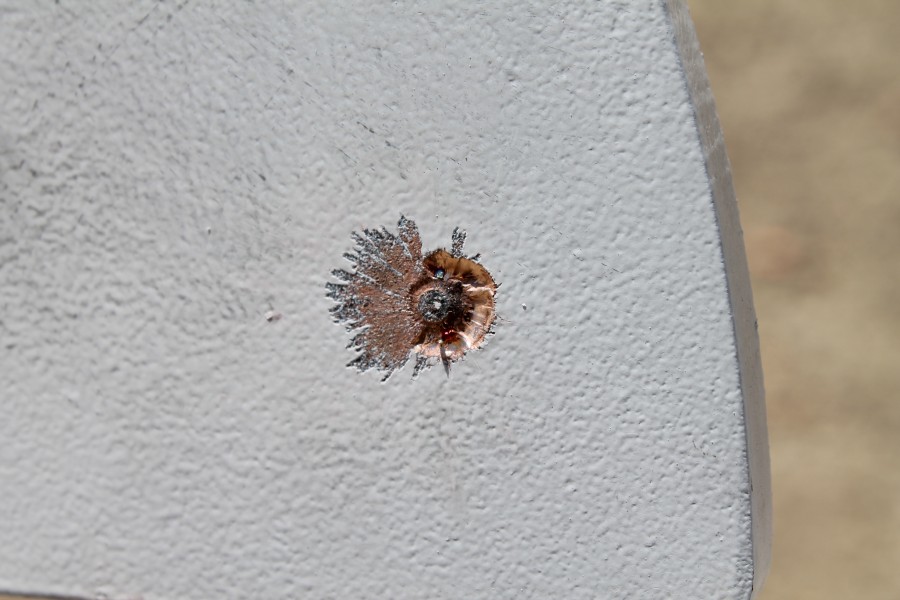
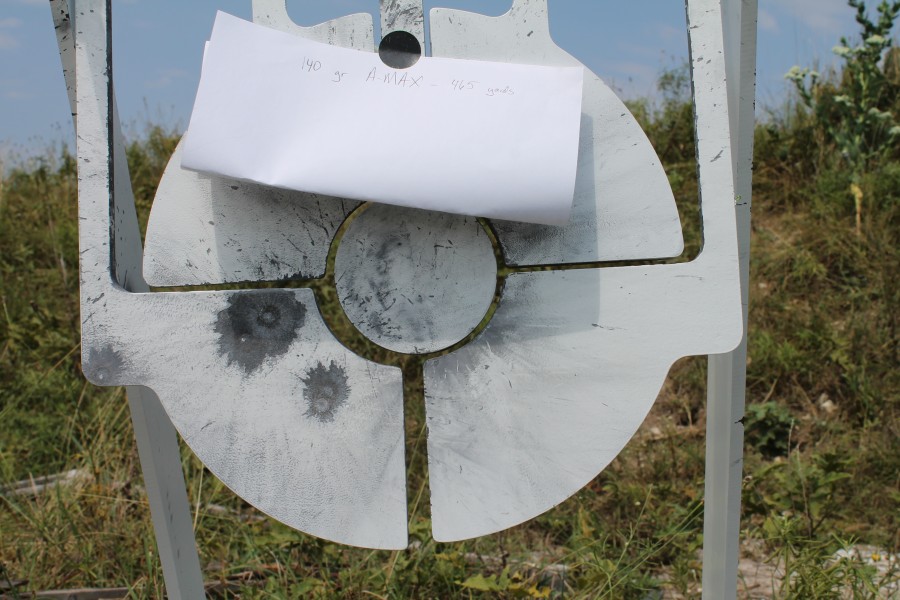



Love the design!
ditto.
This thing and a hostage silhouette with swinger, and I’d be set.
I have both and it is just as awesome as you think it is.
I thought I was happy with just the Action Target PT hostage (tip: buy from Brownells during a sale). Now I need this too.
I wish companies could custom cut the plate, and THEN do the heat treat necessary to bring the hardness up, it would completely eliminate the HAZ for targets like this. I don’t know where that would be cost wise though compared to other methods.
If you want the very best edge hardness, without post process heat treating, you need to go to someone who does water jet cutting.
The solution is definitely water-jet cutting. The cost of re-heat treating the metal after cutting would make the targets too expensive.
“The solution is definitely water-jet cutting. The cost of re-heat treating the metal after cutting would make the targets too expensive.”
Or EDM. EDM is likely just as or even more expensive…
Hurry up and advance the tech so we can afford it, will ya?
For those of you who also keep in practice by using a precision airgun, there’s a guy that offers similar targets for $30-50:
http://www.steelplinkers.com/Quadrant.html
http://www.steelplinkers.com/Spinners.html (scroll down to the “sight ‘n spin”)
I use one at 50 yards with my .22 Mrod. Works great.
Really cool, and I would totally pay the (relatively) high cost of this…
…if I had a place to use it!
Really. 56 lbs isn’t something I’d be dragging out to the BLM range every time I went shooting. Heck, at my age, I might have a hard time just picking it up!
Come on guys , no one realized this thing looks like the death star? “That’s no moon”
Until you paint it red & white, then it’ll look like a Pokeball.
What is this poke of which you speak? Nintendo is for kids 😉
This is really neat. This takes the fun of shooting steel up to eleven!
Good article but no video?
This thing is begging for four colors of brightly colored spraypaint and the greatest game of Simon ever
That’d be really intense. I’d pay money to play that game!
That sounds like the making of a really good video with some silenced .22 rifles and 10 round magazines.
Things I’m wondering:
How would the randomized patterns be called out?
Could a Simon machine be somehow wired into the target quadrants to register hits?
http://www.amazon.com/Basic-Fun-1897-Simon-Game/dp/B00E9YWJOS
The comments on edge damage need addressing. While waterjet does not change the temperature of the edge as laser or plasma may, it does not prevent edge damage. The edge is damaged due to uneven stresses at the impact point, because of lack of support outside the edge. It can happen no matter how the steel is cut. The damage area is always larger than the affected zone of the heat treat,which is generally less than 1/64 to 1/32 “, which is less than the damage in the picture. The material, AR500, is heat treated in full width sheets 96” wide, and comes to full hardness in that process, and it’s properties are fixed at that time. Re heat treating is not an option.
I understand the reviewer’s various ranges and ammo types, as he was trying to “test” the limits of the target, and this is a good demonstartion of why the manufacturers recommendations on range and velocity need to be followed for long target life and safe shooting. At Custom Metal Products (custommetalprod.com), the targets we manufacture are all made of AR500 steel, even those for 22LR rimfire. It is the best and most cost-effective material for today’s shooters.
I wonder how much the steel would cost to just make one of these? I have a buddy that could probably do it. The design looks simple enough.
Tyler, you really said “game changer”! As in, “nevah bin dun befo”.
I’m wondering about long term stability of the lower left and lower right quadrants. That looks like a lot of leverage provided by the long side supports. I’d expect some twisting with use.
It looks awesome, I’d love to have one. Currently I have the use of a bank of six 8″ plates up to 25 yards for pistol use, but no steel for rifle use per range rules.
Guns – Range re shooting and it s PORTABLE. The American Security Gravity Spinning Bullseye Target lets you know know EXACTLY where you’re shooting and it’s PORTABLE.
Dont you guys think it would be much much better if the quadrants were UP DOWN RIGHT LEFT instead of UP-RIGHT, DN-RGHT, LFT-DWN, LFT-UP? I mean… when you hit for instance UP-RIGHT, its no feed back, because you actually cant tell if the shoot was high OR to the right… I see this design repeating and wonder if is it just a copy of a bad design
Comments are closed.